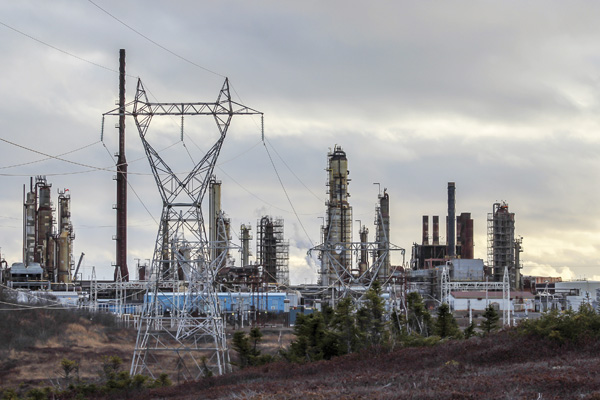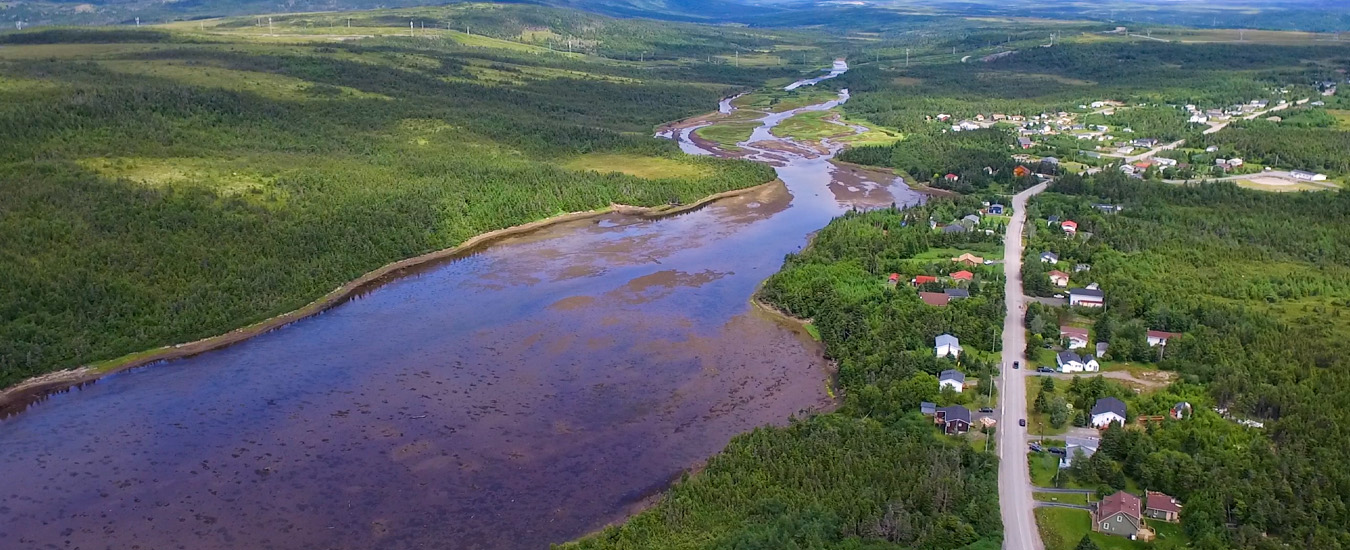With its oil refinery soon producing “green gas” for ravenous world markets, the future of Come By Chance, NL, looks anything but…well…chancy
If you are from Come By Chance, a town of 236 people on the isthmus of Newfoundland and Labrador’s Avalon Peninsula where the main road is called “Main Road”, and someone asks what you call yourself, you might respond the way Kim Downey does.
“You know what,” she says. “We don’t really have labels.”
Downey is 48 years old. She was born and raised here. She went to school here and, apart from a year in Ontario, has spent her entire working life—the past 25 years—as an administrator for Battlefield Equipment Rentals in the industrial park that houses five other tenants. She has a ready and hearty laugh.
Come By Chancian? Come by Chancer? No, she says, it’s not a thing.
Still, it’s a reasonable question. After a year of running in “warm idle” due to COVID-19, the community’s oil refinery, which has been its main employer and economic engine since the early 1970s, is preparing to roar back to life as a lean, green “sustainable aviation fuel and renewable diesel” producing machine. The Texas-based equity firm, which bought a majority stake in the facility from a New York investment house in November—promising to maintain 200 high-paying jobs—is determined to meet the growing international demand for clean fuel on a climate-changing planet.
Given the town’s unprepossessing nature, it’s big news. If the world’s eyes are not yet trained on Come By Chance—this mapmaker’s postscript, this geographic divot whose nearest neighbours are Jack’s Pond to the south and Goobies Station to the North—they soon will be. Shouldn’t a resident know how to properly introduce herself when the time comes for her closeup?
Downey laughs again, but the message is clear. In these days of rolling pandemics, struggling resources industries, relentless global warming, and mothballed factories that suddenly come back to life, anything can happen. Who wants to get pinned down by a label? Call Downey anything you like. Just call her.

Power lines lead into the massive refinery, which is being revamped to produce cleaner energy.
“I think this is a very positive development,” she says. “The way of the future is green. Everything is going green. This step for the refinery is bringing it to the next level. If there’s any future at all, this is the way it’s going to be.”
Most people here feel that way. Colin Holloway, the town’s chief administrative officer, describes an almost palpable sense of relief, mixed with ample dollops of enthusiasm, that’s been absent for some time. “Last year, it was a real devastation to hear that the refinery was potentially not going open and was going to go into warm idle and that the 400-plus individuals that were working there were going to be laid off…These are good jobs. They’re paying $45 to $50 an hour…. The anxiety that residents were feeling a year ago is diminishing. They’ve gone through the hurdle, and they can see a future again. It’s almost as if nothing changed.”
Of course, it has. The new refinery will not be anything like the old one, and neither will the jobs. According to a statement in November, Dallas-based Cresta Management—which bought the interest in the refinery from North Atlantic Refining, owned by Wall Street firm Silverpeak—expects to produce so-called “green gas” for world markets, under the name Braya Renewable Fuels, as early as June.
“Braya will convert the warm-idled refinery into renewable diesel and sustainable aviation fuel service with initial production capacity of 14,000 barrels per day and a planned in-service date of mid-2022,” the statement says. “The Come By Chance refinery is strategically located, with world-class logistical assets...to sell into the United States, Canada and Europe. Braya also will have the ability to grow and adapt alongside increasing North American renewable fuel demand by making modifications to the facility such as expanding total capacity to 35,000 barrels per day, generating green hydrogen, and expanding flexibility.”
Said Chris Rozzel, managing partner at Cresta: “We are pleased to make this transformative investment in the Come By Chance refinery [and] proud to be associated with this new chapter for the refinery as it fully transitions from fossil fuels to the production of sustainable aviation fuel and renewable diesel fuels that will be critical to decarbonizing…heavy transport sectors.”
Added Kaushik Amin, a partner at Silverpeak: “We are excited to partner with Cresta Funds Management to convert the Come By Chance refinery into one of the largest renewable diesel and sustainable aviation fuel production facilities in the world [and create] a sustainable business that will provide long-term jobs and vital economic activity in [Newfoundland and Labrador].”
For locals, the fact that the owners are not government agencies or traditional energy companies actually boosts their confidence in the plan. The evidence, they say, shows that these folks, with their eyes trained to the bottom line, are on to something.
According to the Paris-based International Energy Agency, worldwide share of biofuels in transportation could jump 27 per cent by 2050. Other studies conclude that the appetite for renewable diesel—exactly what the Come By Chance refinery is tooling up to produce—is nothing short of ravenous. “Global capacity is expected to reach 14.6 million tons in 2024, growing [annually] by 21 per cent, while demand [on top of that] is projected to reach 13 million tons,” says Dublin-based Research and Markets.
What’s more, it points out, “the fastest-growing regional market is Europe [with] the launch of Renewable Diesel Directive (RED) II, which has supported the consumption of sustainable fuel options to a great extent and thereby resulted in the increased demand for renewable diesel. [Meanwhile], the growing number of mandates regarding emission control in both automotive as well as aviation industries are contributing to the rising demand for renewable diesel in the Americas and Asia.”
Under the circumstances, it’s tempting to ask: What could go wrong? But this is Newfoundland and Labrador. People here try not to poke that particular bear.
The name “Comby Chance” was first recorded in 1706, says the town’s official history, “perhaps in reference to the discovery of the harbour by chance.” In the decades that followed, the community became a rural hub in the old “cottage hospital” system before the introduction of province-wide Medicare in 1986. Mostly, though, the community’s fortunes have been tethered to industrial schemes and dreams hatched far beyond its near horizons. The refinery, itself, was a good example.
Says the history: “Come By Chance gained national notoriety in the early 1970s with the building of [the] 16,000-cubic-metre-per-day [plant]. The $120-million complex included two 95,000-cubic-metre crude oil storage tanks, a railway spur, a deep-water oil terminal, and the [facility] itself, which produced its first oil in December 1973.”
Things went sideways from there. Shaheen Resources, the refinery’s builder, filed for bankruptcy in 1976, and the operation shut down. Four years after that, Petro-Canada bought and sold it to Newfoundland Energy Ltd., which refurbished it and brought it back online. In 1994, Vitol Refining Group of the Netherlands bought it and invested millions to modernize it. In 2006, Harvest Energy of Calgary bought the refinery and sold it to Korea National Oil Corporation in 2009.
Meanwhile, the town’s history reports, Come By Chance “got dense with industry.” Specifically, “In addition to the oil refinery, the Newfoundland Transshipment Terminal is located within the municipal boundaries of both Come By Chance and nearby Arnold’s Cove. The terminal has six 500,000-barrel storage tanks utilized by the Newfoundland offshore oil producers. Crude is shipped to the terminal by dedicated shuttle tankers and stored in the tanks until it is ready to be shipped to market by second leg tankers. The terminal has been in operation since 1998 and is currently servicing four offshore oil fields.”
COVID-19 and wildly fluctuating oil prices in world markets have taken the mickey out of much of the province’s energy momentum.
Silverpeak has owned the Come By Chance refinery—which, at its peak, refined 130,000 barrels a day and contributed as much as five per cent to the provincial economy—since 2014. They shut it down in 2020 as the pandemic gathered momentum, and the Newfoundland and Labrador government—which has depended on the refinery for a steady oil to meet the province’s domestic needs—has been trying to broker deals for its sale ever since. Cresta now guarantees continued supply of fossil fuel to the province in exchange for a $180-million get-out-of-jail-free card that effectively indemnifies the new owner from liability for environmental contamination for 10 years.
For Holloway, Downey and others, though, dwelling on the past—on what was, rather than what could be—is counterproductive. Sure, they say, the number of refinery jobs have dwindled. On the other hand, consider the alternative.
“The workforce has gone from over 400 to somewhere around 200. I don’t think you see more than 250 or 300,” Holloway concedes. “But there’s still a lot of people working there right now because [the new owners] have had to rehabilitate and repurpose the tanks to move from processing crude to processing used oils. So, lots of people are getting work, and lots of people out there are building the economy.”
Adds Downey: “Even when there’s just a couple of hundred people working, you know, those are people who are keeping their jobs. Plus, there’s a lot of work being done to bring the refinery to where it needs to be to go to this next level. Everyone’s thinking that’s a very positive development for the long term.”
Indeed, orders from the refinery are still pouring in to suppliers at the industrial park. “We always depended on the refinery,” Downey says of her employer, Battlefield Equipment. “We were fortunate enough that when it went down, we did have a lot of other customers that got us through. But there’s no doubt now that it’s up and running again, it’s just fantastic for our business.”
Besides, they say, Come By Chance has always weathered ups and downs and remained standing. It might be easy for outsiders to imagine the tiny community as almost liminal space—a place you go through to get to somewhere else. But there is a hard-beating heart here with everything any little town needs to give itself a name—an identity—it can tell
the world.
“I’m actually getting inquiries now from other similar types of green economy businesses,” Holloway says. “They are reaching out to me wondering what lands are available. Could they piggyback off this new life? These requests are coming in from outside the province. I spoke to somebody two months ago about land. I had another call today wondering about zoning and what kind of reaction would town council have to these types of proposals. There’s actually a referral sitting on my desk. These are businesses I would not have anticipated hearing from before any of this happened.”
That is, indeed, the problem with labels. They almost never stick. Especially these days when almost nothing is certain but just about everything is possible. After all, what would you call yourself if you came from a town called Hope?
